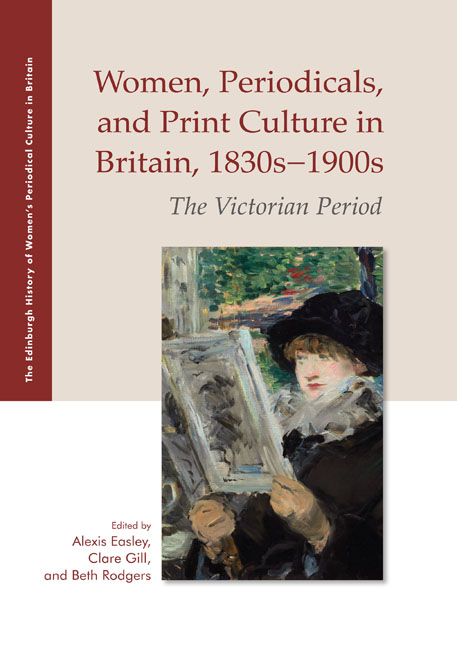Book contents
- Frontmatter
- Contents
- List of Illustrations
- Acknowledgments
- Introduction: Women, Periodicals, and Print Culture in the Victorian Period
- Part I (Re)Imagining Domestic Life
- Part II Constructing Modern Girls and Young Women
- Constructing Modern Girls and Young Women: Introduction
- 7 Promoting a Do-It-Yourself Spirit: Samuel Beeton's Young Englishwoman
- 8 Claiming Medicine as a Profession for Women: The English Woman's Journal's Campaign for Female Doctors
- 9 Encouraging Charitable Work and Membership in the Girls’ Friendly Society through British Girls’ Periodicals
- 10 ‘Welcome and Appeal for the “Maid of Dundee”’: Constructing the Female Working-Class Bard in Ellen Johnston's Correspondence Poetry, 1862–1867
- 11 The Editor of the Period: Alice Corkran, the Girl's Realm, and the Woman Editor
- 12 The ‘Most-Talked-Of Creature in the World’: The ‘American Girl’ in Victorian Print Culture
- Part III Women and Visual Culture
- Part IV Making Space for Women
- Part V Constructing Women Readers and Writers
- Part VI Intervening in Political Debates
- Notes on Contributors
- Index
- Plate section
7 - Promoting a Do-It-Yourself Spirit: Samuel Beeton's Young Englishwoman
from Part II - Constructing Modern Girls and Young Women
Published online by Cambridge University Press: 25 October 2019
- Frontmatter
- Contents
- List of Illustrations
- Acknowledgments
- Introduction: Women, Periodicals, and Print Culture in the Victorian Period
- Part I (Re)Imagining Domestic Life
- Part II Constructing Modern Girls and Young Women
- Constructing Modern Girls and Young Women: Introduction
- 7 Promoting a Do-It-Yourself Spirit: Samuel Beeton's Young Englishwoman
- 8 Claiming Medicine as a Profession for Women: The English Woman's Journal's Campaign for Female Doctors
- 9 Encouraging Charitable Work and Membership in the Girls’ Friendly Society through British Girls’ Periodicals
- 10 ‘Welcome and Appeal for the “Maid of Dundee”’: Constructing the Female Working-Class Bard in Ellen Johnston's Correspondence Poetry, 1862–1867
- 11 The Editor of the Period: Alice Corkran, the Girl's Realm, and the Woman Editor
- 12 The ‘Most-Talked-Of Creature in the World’: The ‘American Girl’ in Victorian Print Culture
- Part III Women and Visual Culture
- Part IV Making Space for Women
- Part V Constructing Women Readers and Writers
- Part VI Intervening in Political Debates
- Notes on Contributors
- Index
- Plate section
Summary
SAMUEL BEETON, KNOWN PRIMARILY for publishing the Englishwoman's Domestic Magazine (1852–79) and Mrs Beeton's Book of Household Management (1861), was a successful publishing entrepreneur who founded a slate of magazines for middleclass women, boys, and girls. His Boy's Own Magazine (1855–74) and its counterpart the Young Englishwoman (1864–77) are milestones in Victorian periodical history as they were among the earliest magazines aimed at target audiences defined not only by age but also by sex. Kristine Moruzi points out that in 1824 only five magazines for young people were published in England; by 1900 there were 160. However, most children's magazines were short-lived with runs of a year or less while just a handful lasted multiple years (2016: 294). Earlier in the century, youth periodicals tended to have a religious bent and were often aimed at both boys and girls, but as the century progressed ‘gendered reading became … more strictly demarcated’ (301). Beeton was an early adopter of niche marketing to boys and girls, and the long-lived success of his Boy's Own Magazine bolstered his theory that more narrowly defined audiences were viable targets for new periodicals. Beeton's savvy ability to imagine new audiences and craft ingenious strategies to engage them helped him build a network of ‘Beeton readers’ that supported his expanding periodical empire.
The Young Englishwoman, first published in December 1864, was a particularly risky venture despite Edward Harrison's launch of the Young Ladies’ Journal earlier that year (Beetham and Boardman 2001: 71). According to Kathryn Hughes, ‘conventional wisdom suggested that there was no point in producing a magazine directed at teenage girls since in this period they moved from childhood to adulthood without inhabiting any transitional stage. While Beeton had triumphantly shown that male adolescents were hungry for a literature of their own, it was far from clear that he could pull off the same trick with their sisters’ (2005: 296). Although the Young Englishwoman's fashion plates and usable patterns for clothing, accessories, and home handicrafts were expensive to produce, including these features paid off. The debut of the Young Englishwoman ‘was one of the brighter moments in the sad months to come’ when Sam's wife and collaborator Isabella would die unexpectedly in February 1865 at the age of twenty-eight after giving birth to her second surviving son.
- Type
- Chapter
- Information
- Women, Periodicals and Print Culture in Britain, 1830s–1900sThe Victorian Period, pp. 103 - 119Publisher: Edinburgh University PressPrint publication year: 2019



